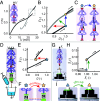Exotic mechanical properties enabled by countersnapping instabilities
- PMID: 40244676
- PMCID: PMC12036990
- DOI: 10.1073/pnas.2423301122
Exotic mechanical properties enabled by countersnapping instabilities
Abstract
Mechanical snapping instabilities are leveraged by natural systems, metamaterials, and devices for rapid sensing, actuation, and shape changes, as well as to absorb impact. In all current forms of snapping, shapes deform in the same direction as the exerted forces, even though there is no physical law that dictates this. Here, we realize countersnapping mechanical structures that respond in the opposite way. In contrast to regular snapping, countersnapping manifests itself in a sudden shortening transition under increasing tension or a sudden increase in tensile force under increasing extension. We design these structures by combining basic flexible building blocks that leverage geometric nonlinearities. We demonstrate experimentally that countersnapping can be employed to obtain new exotic properties, such as unidirectional stick-slip motion, switchable stiffness that does not otherwise affect the state of the system, and passive resonance avoidance. Moreover, we demonstrate that combining multiple countersnapping elements allows sequential stiffness switching for elements coupled in parallel, or instantaneous collective switching for elements in series. By expanding the repertoire of realizable elastic instabilities, our work opens routes to principles for mechanical sensing, computation, and actuation.
Keywords: elastic instabilities; geometric nonlinearities; mechanical metamaterials; programmability; snapping.
Conflict of interest statement
Competing interests statement:The authors declare no competing interest.
Figures






References
-
- Bertoldi K., Reis P. M., Willshaw S., Mullin T., Negative Poisson’s ratio behavior induced by an elastic instability. Adv. Mater. 22, 361–366 (2010). - PubMed
-
- Shan S., et al. , Multistable architected materials for trapping elastic strain energy. Adv. Mater. 27, 4296–4301 (2015). - PubMed
-
- Yang H., Ma L., Multi-stable mechanical metamaterials by elastic buckling instability. J. Mater. Sci. 54, 3509–3526 (2019).
-
- Wu L., Pasini D., In situ activation of snap-through instability in multi-response metamaterials through multistable topological transformation. Adv. Mater. 35, 2301109 (2023). - PubMed
LinkOut - more resources
Full Text Sources

